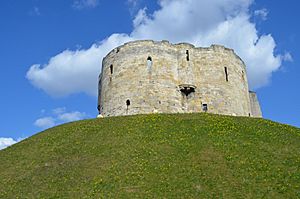Robert Aske (political leader) facts for kids
Quick facts for kids
Robert Aske
|
|
|---|---|
| Born | c. 1500 |
| Died | 12 July 1537 (aged 36–37) |
| Occupation | Lawyer |

Robert Aske (around 1500 – 12 July 1537) was an English lawyer. He became famous for leading a big protest called the Pilgrimage of Grace. This protest was against King Henry VIII's decision to close down monasteries in 1536. Robert Aske was later put to death for going against the King.
Contents
Robert Aske's Early Life
Robert Aske was born around the year 1500. He was from an old family in Yorkshire, England. His family had some important connections. For example, his mother was related to a powerful family called the Cliffords. He was also a distant cousin of Queen Jane Seymour, one of King Henry VIII's wives.
Aske studied law and became a barrister. This meant he was a type of lawyer who could argue cases in court. He was a very religious man. He did not agree with King Henry VIII's changes to the church. Especially, he was upset about the King closing down monasteries.
The Pilgrimage of Grace
In 1536, people in York started to protest against King Henry VIII. Robert Aske was traveling back to Yorkshire from London when this protest began. He was not involved at first. But he soon decided to join the rebels and became their main leader. By October 10, 1536, people saw him as their "chief captain."
The protest grew very quickly. Most of Yorkshire joined in, along with parts of other areas like Northumberland and Durham. About nine thousand protesters marched to York. Aske made sure that the monks and nuns who had been forced out could return to their homes. Religious services started again in these places.
Meeting the King
On November 13, 1536, Robert Aske met with the King's representatives. One of them was Thomas Howard, 3rd Duke of Norfolk. Aske was promised that he could meet the King safely. The protesters had several demands. They wanted the King to punish bishops they thought were wrong. They also wanted him to get rid of his "evil advisers." They asked the King to cancel his laws against the church. And they wanted a new parliament meeting to be held in the North of England.
Aske then traveled to London and met King Henry VIII. The King promised to fix some of the problems. He also promised Aske safe travel back home.
Aske's Arrest and Execution
As Robert Aske started his journey back north, more fighting broke out. This new fighting made King Henry change his mind. The King had Aske arrested and taken to the Tower of London.
Aske was found guilty of high treason. This meant he was accused of going against the King. He was then taken back to York. On July 12, 1537, Robert Aske was executed. He was put to death on a platform built outside Clifford's Tower.
Portrayals of Robert Aske
We do not have any pictures of Robert Aske from his time. All we know about how he looked is that he was blind in one eye.
Robert Aske has been shown in movies and TV shows.
- In the TV show Henry VIII (2003), actor Sean Bean played Aske. However, the show incorrectly showed him as a violent soldier.
- Gerard McSorley played Aske in the TV show The Tudors. The actor was much older than Aske was when he died. The show also showed Aske with a family, but he was not married in real life.
Aske's story also appears in books.
- The novel Sovereign by C. J. Sansom talks a lot about Aske's life.
- The Man on a Donkey by H. F. M. Prescott also features him.
- The book The Mirror and the Light by Hilary Mantel describes the Pilgrimage of Grace. It shows the events through the eyes of Thomas Cromwell, who was a main adviser to King Henry VIII.
Images for kids
See also
 In Spanish: Robert Aske para niños
In Spanish: Robert Aske para niños
- All Saints Church, Aughton


